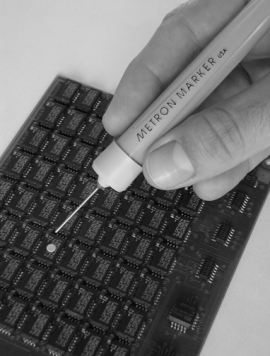How to use your Metron Markers

Product information and helpful hints on using the Metron Markers
THE PEN
With the cap on, shake the pen for 10 or 15 seconds to activate the ink flow. Pull off the cap and, with the pen in marking position, give it a little squeeze. This is how you feed and control the ink. For a little dot, a little squeeze. For a continuous line, a continuous squeeze. To do lettering, just keep the tip of the needle wet and draw the lines.
When you release the finger pressure, the pen will suck the ink out of the needle point so that is won’t harden in the tube. With the Permanent and Removable Inks, the pen can be used uncapped all day long without clogging if you stand it with the needle point upward when you are not using it. If you lay it down with the cap off it may clog in about an hour if it isn’t in use. If you are not going to be using it for long periods, put the cap back on and it won’t dry out or clog.
THE CAP
The cap acts as a pump to force the ink back into the tube as you push it on. If your pen should become clogged, it can usually be freed by using the cap like a pump. For stubborn cases, put a drop of water on the cap entrance, hold the pen vertically and pump the needle in and out of the cap. There is also a cleanout wire provided in every package to open up the most difficult clogs.
THE NEEDLES
There are three different size needles available. The standard needle is 1” in length and has an orifice of 0.031”. The Microtip needle (M) is 1” in length and has and orifice is 0.013”. For the smallest dot or for fine lettering the Microtip is easier to use. The long tip needle (L) is 3.25” in length with an orifice of 0.031”. The long tip needle is useful in hard to reach places.
THE INKS
There is a large supply of ink in the pen over 12,000 dots of ink with the standard tip and some 25,000 dots with the Microtip. Most of these inks use water as a base carrier instead of solvents, so they do not contribute to atmospheric contamination. Drying time will depend on the amount of ink dispersed.
If you maintain the moisture level of the ink, you can use it to the last drop. The Permanent, Removable and Solvent Resistant inks do not polymerize until the water is evaporated.
Most of the inks are normally the consistency of thick cream. The Metron Marker is available in four different types of water-based ink:
- Removable
- Permanent
- Solvent Resistant
- Liquid 2-Way Tape.
The inks are water based and after an extended period of time, may tend to thicken as they lose water. To thin the ink to the consistency of cream, place a drop of water in the opening of the cap and suck it up with the tip of the pen. Vigorous shaking (with cap on) will mix the water and the ink. Warming the pen under a lamp (or in hot water) will make the ink flow and mix more rapidly.
The Solvent Washoff ink, Aquaclean, and Solder Fluxes are alcohol based and may be thinned if necessary with alcohol.
The Metron Marker Inks are electrically nonconductive. The extreme brightness of the colors results from highly fluorescent pigments which convert energy from the blue and ultraviolet range beyond the visible spectrum into very pure emitted light at narrow waveband wavelengths in the visible spectrum. They also reflect as well as emit these same wavelengths to produce the extremely bright and intense
colors.
1) THE REMOVABLE INK, when dry, can be flicked or snapped off with the fingernail. It can also be removed with a cloth or stiff brush dampened in water or almost any solvent. The binder in the ink will dissolve but the pigment itself is not soluble in most solvents so, therefore, it will not bleed or stain. It is intended to be an easily removable, non-destructive ink.
2) THE PERMANENT INK is waterproof and flexible. It may be used as a torque seal. It may be removed with solvents such as Acetone or Trichlorethane and a stiff brush.
Both the Removable and Permanent inks will write on almost anything; glass, plastic, metal even on Teflon and oily surfaces. Adhesion will, of course, vary with the surface to which it is applied.
3) THE SOLVENT RESISTANT INK is an entirely unique kind of marking liquid with some remarkable resistance to a wide range of solvents and extremely good adhesion to some difficult materials. It will withstand boiling in Trichlorethylene, Acetone, Carbon Tetrachloride, Methyl Ethyl Ketone, alcohols, Freon, Benzol, Cyclohexane and virtually any known organic solvent. It does not etch or attack most surfaces. It has exceptionally good adhesion to glass, quartz, ceramics, aluminum, steel, stainless steel, galvanized steel, solder, chrome and most plastics including polyethylene. It will even mark on Teflon if a very light oil film is applied to the Teflon.
Solvent Resistant ink is a non-toxic, waterbased, one part ink with indefinite shelf life so long as moisture loss is replaced. It requires no hardening or baking. It will withstand about 350ºF. before the fluorescent pigments begin to change color. Solvent Resistant inks (except black, red and white) when applied on glass or plastic surfaces and heated in air above 200ºF may become water resistant as well as Solvent Resistant. If you intend to remove it with water don’t bake it.
When the Metron Marker Pen with Solvent Resistant ink stands motionless, the pigments will separate in a few hours. There is a “shaker” in each pen which will readily put the pigment back into uniform suspension when the pen is shaken.
Solvent Resistant ink when dry is relatively hard but soft enough to permit a sharp object to scratch through it without chipping off the rest of the mark. Solvent Resistant ink may be removed easily and completely in HOT WATER, providing it has not been baked. The Solvent Resistant ink is so unique it is Patented.
4) THE AQUACLEAN INK flushed off very easily and thoroughly with hot water. It is a very thick, fast-drying ink. Aquaclean ink is a specialized ink that was originally developed for use on G10 glass filled epoxy P.C. Boards used for military applications. It is used for marking faults (such as incomplete flux removal) where the P.C. Board will then go through Freon or Trichlorethane degreasers. The Aquaclean ink must withstand such degreaser action so that the fault (traces of flux) can be rechecked after degreasing. Final cleaning is done with hot water.
5) THE SOLVENT WASHOFF INK will flush off readily with a hot solvent spray such as in a degreaser. Solvent Washoff ink has a neutral solder flux base. The pigment in this ink may settle, so there is a shaker” is each pen to keep it mixed. It is important that this ink be very thoroughly mixed to facilitate easy removal. This ink may be used to mark soldering errors. It may also be used for marking components. Put your mark beside the error -not on it or you will melt the pigment when you resolder. Solvent Washoff ink has a 3-4 month shelf life.
6) THE LIQUID 2-WAY TAPE is an excellent pressure sensitive adhesive. It is an adhesive which dries in about 20 minutes to a “tacky” surface, does not tend to harden or get sticky with time. It may be applied to nuts or bolts for “vibration proofing”. The bolt may be removed over and over again. It adheres to Teflon. Use also for prepositioning parts, film overlays.
7) THE METRONLUBE-1 ELECTRICAL CONTACT LUBRICANT is an excellent electrical contact lubricant which is very effective even where contact force is high. It is colorless, chemically neutral, water repellent, physiologically safe, light, weather proof and does not volatize easily. It protects base metals against corrosion and oxidation. A thin film reduces the coefficient of friction for copper, silver or gold-plated surfaces to 0.05-0.15 and can increase the life of hard gold-plated contacts by as much as 100 times. It is excellent for contacts such as P.C. Board “fingers” because it prevents oxides and sulfides from forming and increasing electrical resistance.
Where long life is important, this contact lubricant is superior to mineral based products, is thermally stable, silicon free won’t sum or vaporize has good wetting properties on metal, does not combine with water, has optimum viscosity with low temperature coefficients and a relatively low specific-resistance. Metronlube-1 is also an excellent high-grade, non-gumming, non-vaporizing lubricant for mechanical uses from –55ºC to =250ºC.
SOLDER FLUXES. Available in assorted formulas for RMA, water clean, and no clean. Microtip is standard on fluxes
SUGGESTIONS:
While the Metron Marker is intended primarily as a marking instrument rather than a writing instrument, it can also be used for lettering. Your lettering will be neater if you avoid the temptation to squeeze the pen at the beginning of each stroke of a letter and keep the ink supply at the tip of the pen to a minimum. Lettering is easier if you DRAW the letters.
If you have a special need or a special material you would like to use in a pen call us and we will try to help.
Made in the USA
PATENTED
SHELF LIFE: The shelf life of a Metron Marker Pen is almost indefinite if the moisture level is maintained. Airtight, moisture proof storage is the best way of maintaining the moisture level of the inks. The ink may thicken if not properly stored in as little as three months. The viscosity can be restored to normal, however, by placing a drop of water in the depression of the cap of the pen, sucking it into the pen and then vigorously shaking
Manufactured by Metron Optics, Inc., San Diego, California USA

